
|

|
LeMat Revolver: A History
LeMat Revolver
| LeMat Revolver and the Civil War |
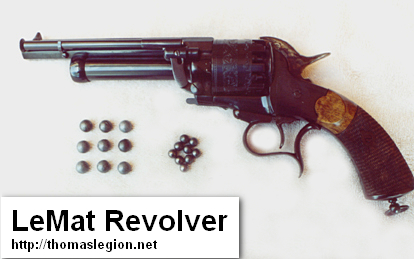
|
| LeMat Revolver |
Introduction
Consider the famous Gunfight at the O.K. Corral which lasted all of 30 seconds and
resulted in 3 deaths. In this fight were the likes of Virgil, Morgan,
and Wyatt Earp, and Doc Holliday vs. Tom and Frank McLaury, Billy and Ike Clanton, and Billy Claiborne (vacates scene after
initial shots fired). To better appreciate the complexities of a gunfight, consider how O.K. Corral involved
some of the best pistoliers of the era. At close distance, initially about 6 feet, the fight involved revolvers and a
single short, double-barreled shotgun, and while at such close proximity and with 30 shots fired in merely 30 seconds, the
outcome was 3 killed and 3 wounded. The best gunmen at this short distance were able to hit their mark
roughly one out of every five rounds. In other words, 24 shots completely missed their mark. The outcome was Virgil and
Morgan wounded; Doc Holliday grazed; Tom and Frank McLaury and Billy Clanton killed.
(Right) LeMat revolver with 9 bullets and buckshot. Because its ammunition unleashed a killing
swath similar to the larger artillery shot, the LeMat was commonly referred to as "the grapeshot revolver."
During the Civil War much of the fighting was at distances of 50 to 100
yards and some of the battles were fought while atop chargers and swift steeds. The average soldier was less than
an accurate shot, because many of the men had never even held a firearm prior to hostilities. A reliable weapon
meant everything, and most soldiers had to rely upon outdated smoothbores and single shot pistols. Only a few soldiers knew
about the LeMat revolver and even fewer would ever grip the piece. The LeMat had a .42-caliber upper barrel
fed by a nine-round cylinder and a lower .63-caliber (approximately 16-gauge) smoothbore barrel that was loaded with buckshot.
The shooter selected which barrel would fire by rotating a pivoting striker on the hammer. The weapon itself had no impact on any given battle of the conflict, but it was a powerful firearm
exuding overwhelming confidence to those who wielded it in the fight. At close range, it could unleash fatal blows to all
who were unfortunate to challenge or cross it. Though limited production restricted its battlefield application, the
LeMat served well in its intended role as a close-range sidearm for soldiers on horseback. The ability to fire nine round
balls and a blast of buckshot made it a devastating weapon inside 25 yds., earning it the nickname "the grapeshot revolver."
Summary
With a limited production of some 2,900 revolvers, and approximately
2,500 purchased by the Confederacy, the LeMat was typically found in the hands of a Confederate general, colonel, and
even dignitary, and it was more of a weapon of confidence than anything else. The LeMat, produced 1856–65, was an over/under
handgun sporting a revolver and shotgun combination, and it was manufactured in France, Belgium, and England. The lethal LeMat was a .42 or .36 caliber cap & ball black powder revolver
invented and patented by Jean Alexandre LeMat of New Orleans, and it featured an unusual secondary 20 gauge
smoothbore barrel capable of firing buckshot. Some variations of the LeMat design appeared
late in the Civil War, including a lighter version featuring a .35- or .36-caliber cylinder and barrel over a 28-gauge smoothbore
barrel. Whereas it was considered inaccurate beyond 25 yards, the LeMat was the sidearm favored by notable
cavalryman JEB Stuart and it was appreciated by the likes of Braxton Bragg, Richard H. Anderson, and
Major Henry Wirz.
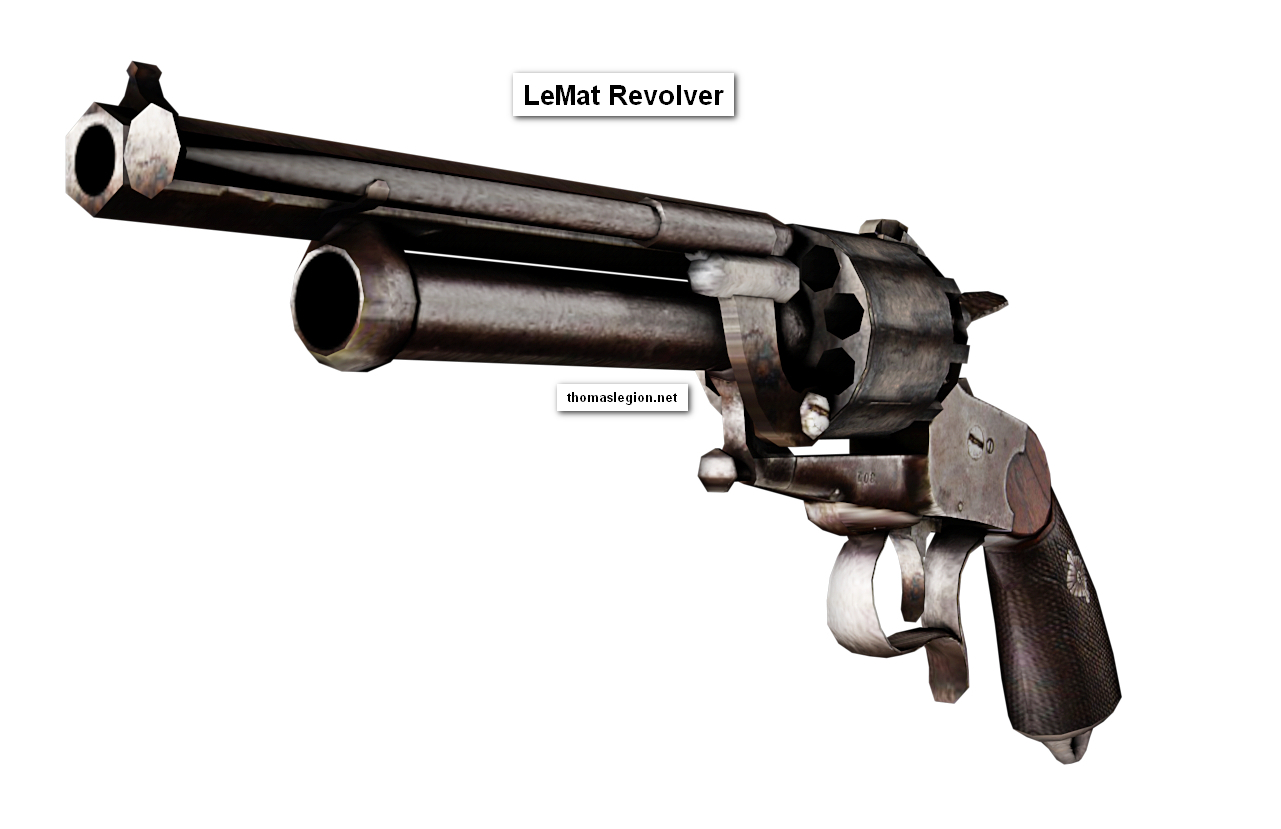
|
| LeMat Revolver |
|

|

|

|

|
History
A heavy, powerful and unique revolver, the LeMat
revolver was developed by Dr. Jean Alexandre Francois LeMat of New Orleans with the assistance of P.G.T. Beauregard, who later
became one of the Confederacy's best-known generals.
LeMats were made from 1856 to 1865 at plants in Paris, France and Birmingham, England.
In addition to Beauregard, J.E.B. Stuart, Richard Anderson and Braxton Bragg were among the Confederate generals who favored
LeMats. At a cost of $35 in 1861, the limited production LeMat was more than
twice the price of a Colt, making it both too rare and too expensive for the lower ranks.
The mid-19th century was a time
in American history that gave birth to a number of innovative firearm designs. This unique sidearm was also known as
the "grape shot revolver." It was developed in New Orleans in 1856 by Jean Alexander Le Mat, whose manufacturing effort was
backed by Major P.G.T. Beauregard, U.S. Army, who would later serve as a general in the Confederate Army. Less than
100 were made by John Krider of Philadelphia, Pennsylvania, in 1859, including the first 25 prototypes. It is estimated that
2,900 were produced in Liege, Belgium and Paris, France. The European made pistols were shipped through Birmingham, England
where they were proof marked.
Approximately 900 revolvers were shipped to the Confederate Army and 600
to the Confederate Navy through Bermuda to avoid the Southern Naval Blockade. Of the nearly 2,900 made, it's estimated that 2,500
made it through the Union blockage into service with the Confederacy.
The distinguishing characteristic of LeMat's revolver is that its 9-shot
cylinder revolves around a separate central barrel of larger caliber than the chambers in the cylinder proper. The central
barrel is smoothbore and can function as a short-barreled shotgun (hence the name "Grape Shot Revolver") with the shooter
selecting whether to fire from the cylinder or the smoothbore barrel by flipping a lever on the end of the hammer. Flipping
the lever up caused the movable striker to fall upon the primer set directly under the hammer, discharging the lower barrel,
while leaving it in the standard position would fire the chambers in the cylinder, much like any other revolver. LeMat originally
chambered his pistol for .40 (or .42) caliber revolver bullets, with a .60 (20 gauge) smoothbore barrel, and had a jointed
ramrod (mounted on the right-hand side of the frame), which was used to load both barrels. Later, during the American Civil
War, a lighter .35-caliber pistol with a .55 caliber (28-gauge) smoothbore barrel was produced, but as these were non-standard
ammunition sizes (.36 or .44 caliber were most common for contemporary revolvers) LeMat owners had to cast their own bullets,
as opposed to being issued them from general military stores. The final models of the LeMat were produced in .36 or .44 caliber
in response to these criticisms, but too few of them managed to get past the Union blockade of the South during the Civil
War to be of any real use.
| LeMat Revolver |
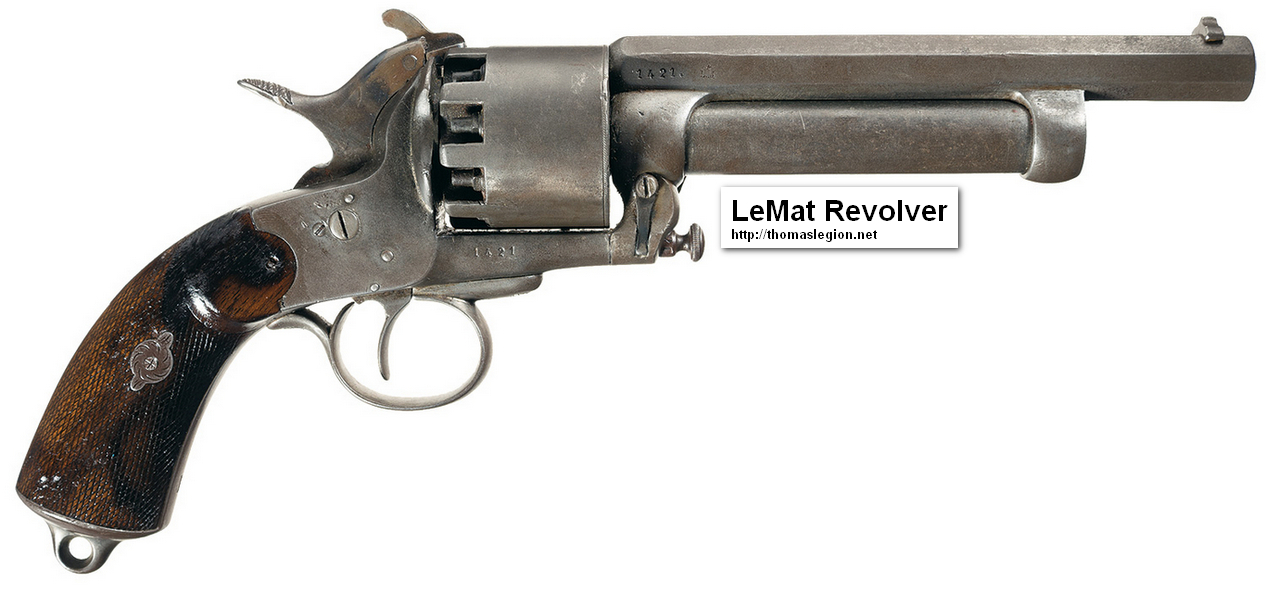
|
| High Resolution Photo of LeMat Revolver |
| LeMat Revolver |
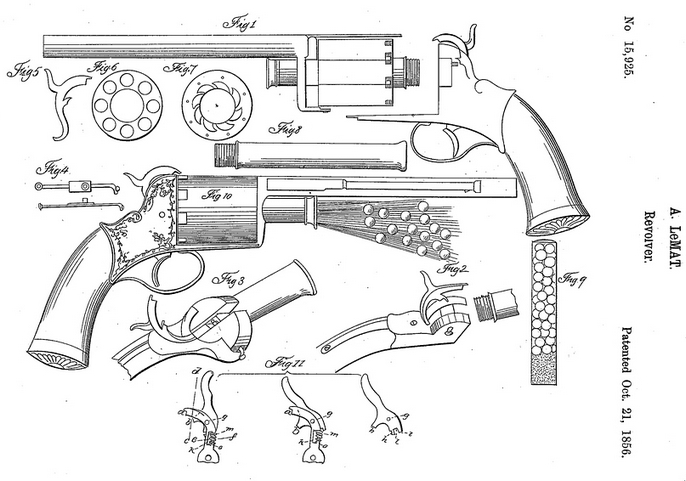
|
| LeMat Revolver patent |
Characteristics and Specifications
Nomenclature: LeMat Revolver
Type: Grapeshot Revolver/Service Pistol
Place
of origin: Confederate States of America
Service: 1861–1865
Operators: Confederate States
Employment: Confederate
Army, Approx. 2,500
Hostilities: American Civil War (1861-1865)
Designer: Jean Alexandre LeMat
Designed: 1855; US
Patent 1856
Manufacturer: John Krider of Philadelphia, USA; Charles Frederic Girard and Son of Paris, France; London Armoury
Company, UK
Produced: 1856–65
Number Built: Approx. 2,900
Price: $35 1861
Variants: Revolver; Carbine
Action Type: Single-Action 2-Barrel Revolver
Action: Single Action Revolver; Underslung Single Barrel Shotgun
Overall
Length: 13.25 in (356 mm)
Barrel Length: 6.75 inches
Weight (Unloaded): 3.1 lb (1.41 kg)
Caliber:
.36 or .44 Ball / 16 or 20ga Buckshot
Cartridge: .42 Ball (.44 Repro) or .36 Ball; 16ga or 20ga Shot
Barrels: 2
Hammer-Action:
Percussion Cap; Single-Action
Feed: 9-Shot Revolving Cylinder; Single-Shot Smoothbore Secondary Barrel
Capacity: 9 (.44),
1 (Buck or Ball Load)
Rate-of-Fire: 9 Rounds/Minute
Muzzle Velocity: 620 ft/s (190 m/s)
Effective Firing
Range: 40 yd (37 m)
Maximum Firing Range: 100 yd
Sights: Fixed Front Post; Rear Notch
American Civil War
LeMat hoped to market his adaptable revolver as a primary sidearm for dragoons
and other mounted troops. He entered into a partnership with P.G.T. Beauregard (at that time a major in the U.S. Army) in
April 1859 to market his handgun to the U.S. Army. Beauregard, also LeMat's cousin, was one of the first U.S. Army officers
to resign and join the Confederacy.
When war broke out LeMat received Confederate contracts for the production
of five thousand revolvers, and plans were laid to manufacture the gun abroad and then import them into the Confederacy, which
lacked the necessary facilities to produce the weapon locally. Confederate gun runners were able to slip shipments of the
gun through the Union naval blockade and it is estimated that about 2,500 made it into Confederate service.
In addition to General Beauregard and Colonel LeMat, LeMat’s revolver
was used by such famous Confederate officers as Major Generals Braxton Bragg, J.E.B. Stuart, Richard H. Anderson, and Major
Henry Wirz. Confederate Major General J.E.B. Stuart "was known to favor the LeMat revolver". General Beauregard's personal
engraved LeMat, which he carried throughout the war, is preserved at the Museum of the Confederacy in Richmond, Virginia.
The LeMat revolver was manufactured from 1856 to 1865, with approximately
2,900 being produced. The first models were manufactured by John Krider of Philadelphia, with the second model (the first
overseas model), being produced by Charles Frederic Girard and Son of Paris. Quality concerns prompted LeMat to consider production
at the Birmingham Small Arms Company in Birmingham, England, but production was never mounted there. LeMat revolvers from
France were shipped to the Confederate forces via the United Kingdom, and all firearms landed in the UK were (and still are)
required to be proofed. The LeMats which found their way through the Union blockade were stamped with British proof marks
from the Birmingham Proof House, leading to the misapprehension that the pistols were actually manufactured in the UK. A handful
are known to have been made illegitimately in the UK by an unknown manufacturer, believed to be the London Armoury Company,
but only two examples survive to the present day and it is doubtful any of the English-made LeMats ever saw service during
the American Civil War.
The original revolver, constructed of blued steel with grips of checkered
walnut, was not considered to be a very accurate weapon although it was deadly at close range. Civil War cavalrymen, particularly
in the South, preferred to carry several pistols, as it was faster to draw another loaded weapon than it was to try to reload
a cap and ball revolver in combat.
After the introduction of cartridge-firing firearms, the LeMat system appeared
in pinfire, but this version is exceedingly rare. A centerfire version in 12mm Perrin or 11mm Chamelot-Delvigne, with a 24
gauge shot barrel was made in later years in Belgium. While having better sales than its pinfire relative, the centerfire
LeMat also had no real commercial success due to the invention of the double-action system. With both weapons, loading was
accomplished via a loading gate located at the 4 o'clock position for the cylinder, and by swinging the breech of the shot
barrel up and left.
| Genuine LeMat Revolver with Oak Case |
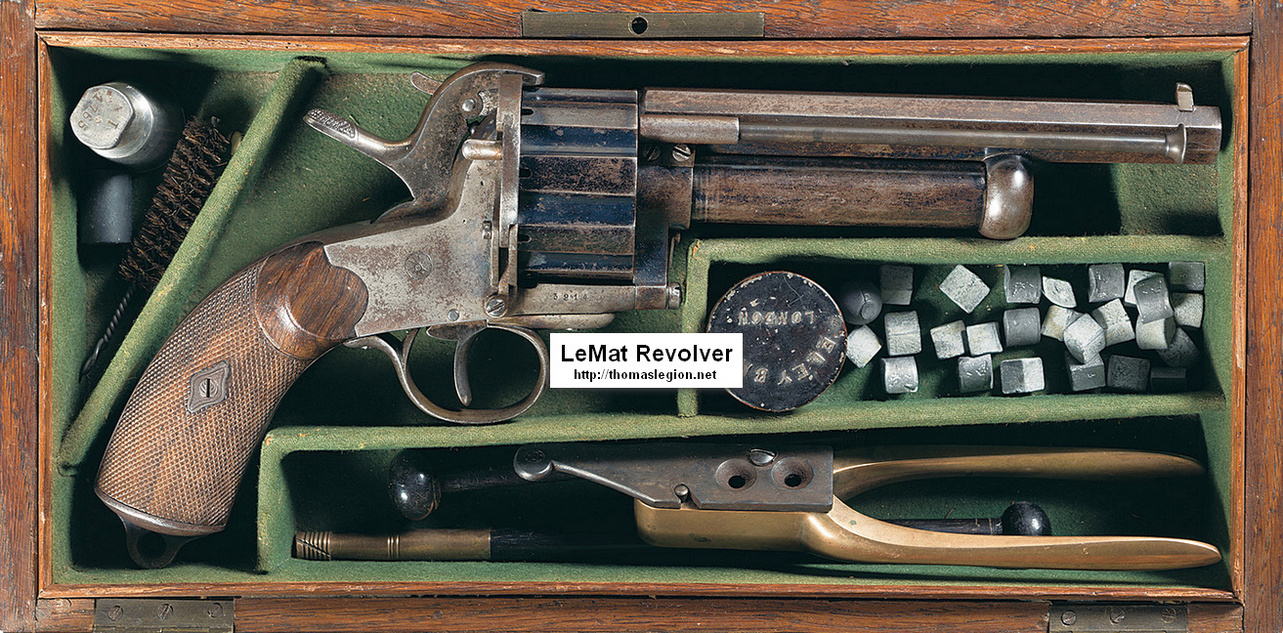
|
| Original LeMat Revolver and Oak Case |
(About) Pinfire LeMat revolver manufactured in Liege, Belgium, between 1863
and 1865. The revolver has an oak case with four compartments lined with green velvet.
Rare Cased Pinfire LeMat Grapeshot Revolver Pinfire LeMat revolver manufactured in Liege, Belgium,
between 1863 and 1865. The revolver has a 6 1/2 inch octagon barrel and
nine shot cylinder chambered for the 12 M/M Lefaucheux pinfire cartridge and fluted nine-shot cylinder along with the distinctive
LeMat 4 1/2-inch 20 gauge smoothbore "grapeshot" barrel. The percussion grapeshot barrel is fired by a pivoting firing pin
on the hammer. An ejector rod is mounted on the right side of the frame with two screws. The revolver has a side-swinging
loading gate on the right side of the frame, round trigger guard with no spur and butt with integral lanyard loop. The right
side of the barrel is marked "COL A. LEMAT BTE." behind the ejector rod. The encircled Liege "E/LG/*" proof mark is stamped
on the front face of the cylinder. "Crown/EL" is stamped on the left side of the barrel, and small "Crown/V" inspection marks
are stamped on the left side of both barrels and the frame. The serial number "3214" is stamped on the lower right side of
the frame. The left side of the frame is stamped with the number "182225". The barrels and cylinder have a high polish blue
finish. The frame and trigger guard are color casehardened, and the hammer has a straw colored finish. The revolver has nicely
figured European walnut grips with fine checkering. The case contains: (1) two ebony cleaning rods with brass tips, (2) a
500 count tin of percussion caps embossed "ELEY BROTHERS/LONDON" on the lid, (3) bell-shaped pewter oil bottle stamped "I/1765"
on the top, (4) brass double cavity bullet mold for round balls and three-piece segmented slugs, (5) modern bristle cleaning
brush and (6) several cast 12 M/M round bass and segmented slugs. A small number of LeMat revolvers were chambered for the
12 M/M Lefaucheux pinfire cartridge adopted by the French military circa 1857.
Variants
- Muzzle Loader – The first variant of the LeMat.
- Pinfire Cartridge – Second variant, can be recognized by cylinder.
- Centerfire – The centerfire variant came with a distinctive grip.
- Carbine – A rare variant with extended barrels and a rifle type stock
totaling 20" in length.
- Baby LeMat - The rarest variant of the LeMat is a reduced size version with
a 4 3/4" barrel and the revolver chambered in .32 caliber and the shotgun chambered in .41 bore. Only 100 were produced.
| View of the top of the LeMat Revolver barrel |

|
| Paris made LeMat Revolver |
Conclusion
All versions and variants of the LeMat were slow loading, so
officers during the Civil War would sometimes carry two or more in battle. By 1864, however, most cavalrymen of both
the Union and Confederate armies had shed their sabers for additional firepower. It was not uncommon to witness a trooper
brandishing 3 to 5 revolvers as he pressed his mount into action. Though exerting confidence and allowing the
fighting edge for those who carried the revolver onto the battlefield, the LeMat's limited production, effective
range, heavy weight and complicated loading process prevented it from becoming a decisive weapon during any battle of the
war. With only 2,500 LeMats employed by the Confederacy (1861-1865) and at a cost
of $35 per unit in 1861, the small arm was twice the price of a Colt and nearly three times the monthly pay of a private,
making the sidearm scarce at the time and even rarer to those who are currently in the market for a genuine LeMat.
Americana and making for interesting conversation, the LeMat revolver continues to garnish greater
interest with age. Many Hollywood productions, including the movie Cold Mountain, starring Jude Law and Nicole Kidman, had
a noteworthy scene of Private W.P. Inman, played by Law, finding a LeMat in the crater before discharging it at an enemy
soldier while at point blank range.
Depending on the model and condition, a LeMat can currently sell for
$10,000 to $100,000. With many hybrids and outright fakes circulating, Caveat Emptor! If you are searching
for a genuine LeMat, then you are encouraged to visit the Rock Island Auction Company, rockislandauction.com, and for a reproduction
of the revolver, see cabelas.com.
Sources: Library of Congress; National Archives; National Park Service;
Jean Alexandre LeMat patent images courtesy google.com; Flayderman,
Norm (17 December 2007). Flayderman's Guide to Antique American Firearms and Their Values. Iola, Wisconsin: F+W Media, Inc.
ISBN 0-89689-455-X; Chicoine, David (2005). "The LeMat Revolver". Guns of the New West: A Close Up Look at Modern Replica
Firearms. Iola, Wisconsin: Krause Publications. ISBN 0-87349-768-6; Adler, Dennis (28 March 2011). Guns of the Civil War.
Zenith Imprint. ISBN 978-0-7603-3971-8; Cumpston, Mike (July 2005). "A Hail of Lead-the Confederate LeMat". Percussion Pistols
and Revolvers: History, Performance and Practical Use. iUniverse. ISBN 978-0-595-35796-3; Taffin, John (2005). Single Action
Sixguns. Iola, Wisconsin: Krause Publications. ISBN 1-4402-2694-6; Lewis, Russell E. (4 March 2010). Warman's Civil War Collectibles
Identification and Price Guide. Iola, Wisconsin: Krause Publications. ISBN 1-4402-1522-7; Shideler, Dan (10 May 2011). The
Gun Digest Book of Guns & Prices 2011. Iola, Wisconsin: Gun Digest Books. ISBN 1-4402-1890-0; Frazier, Charles (1997).
Cold Mountain. Atlantic Monthly Press. ISBN 978-0-87113-679-4; The Confederate LeMat Revolver, Doug Adams, Mowbray Publishing,
2005.
Return to American Civil War Homepage

|

|

|

